Published by DVD Beaver in June 2006. Soirry if some of the links no longer work. — J.R.
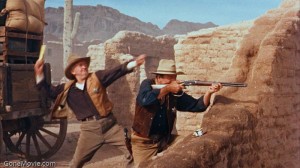
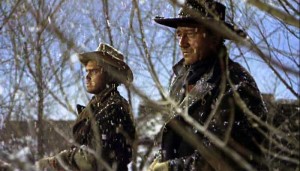
It might be argued that many of the most famous and celebrated westerns qualify as eccentric in one way or another. Rio Bravo mainly consists of friends hanging out together; its memorable action bits are both infrequent and usually over in a matter of seconds. The Searchers often feels like medieval poetry, and its director John Ford once complained that parts of its score seemed more appropriate for Cossacks than for cowboys. Even High Noon has so many titled angles of clocks and reprises of its Tex Ritter theme that you might feel like you’re trapped inside a loop, and it’s hard to think of many sequences more mannerist than the opening one in Once Upon a Time in the West.
The dozen favorites that I’ve listed here are all basically auteurist selections. I’ve restricted myself to only one per director (although I’ve cited other contenders and/or noncontenders by the same filmmakers), and included both ones that are available on DVD and ones that aren’t but should be — or, in some cases, will be. The order is alphabetical:
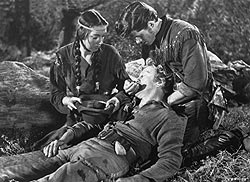
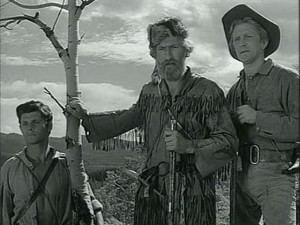
|
1. The Big Sky (Howard Hawks, 1952). This isn’t simply the only Hawks western that doesn’t star John Wayne (not counting his uncredited and piecemeal work on Viva Villa! and The Outlaw), or the only black and white one apart from Red River. It’s uncharacteristic in many other ways. By dealing with trappers and explorers traveling up the Missouri River from St. Louis to Montana in the 1830s, it’s more a riverboat story than a horse opera, with a good many French Creole characters (“Speak English, hoss,” is a recurring line from Arthur Hunnicutt’s Uncle Zeb, the team’s leader). It’s also the only Hawks films in which Native Americans are important (not counting the demonic white brats who play Indians in the next two films he made, Monkey Business and “The Ransom of Red Chief” in O. Henry’s Full House). Furthermore, its two male leads might be described as the most Hawksian team player of all (Dewey Martin as an ornery, racist hick) and the least Hawksian team player of all (Kirk Douglas, too individualistic by temperament to belong to any team). |
Part of what I treasure about this mysterious epic relates to the mysterious bonds that form between these two pals and a captured Blackfoot princess (Elizabeth Threatt, said to be of Cherokee and English descent) who speaks not a word of their language, or vice versa. For a director as conservative and as habitually racist as Hawks, the warm and utopian three-way understandings generated between this unlikely threesome, especially when they spend some time together apart from the other characters, now seem not only multicultural but also downright countercultural. Even though you have to order this movie from France [or the U.K.] or Germany, it’s worth it.
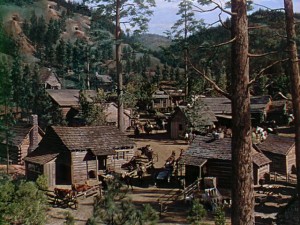
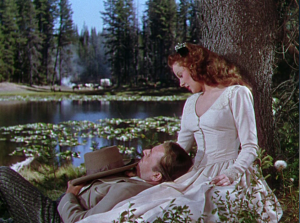
2. Canyon Passage (Jacques Tourneur, 1946). It’s astonishing that not even one of the westerns of Tourneur —- Canyon Passage (1946), Stranger on Horseback (1955), Wichita (1955), or Great Day in the Morning (1956), or either of his fine proto-westerns, the southern Stars in My Crown (1950) or the Argentinian Way of a Gaucho (1952) —- is commercially available at present. [2015: Many of these are now available, including the three best: Stars in My Crown, Canyon Passage, and Wichita.] So let’s work our way down the list and start clamoring for the first, shot in gorgeous color in Oregon. It’s probably the best known as well as the most complex, and in many respects it’s the most impressive. The cast includes Dana Andrews, Susan Hayward, Brian Donlevy, Hoagy Carmichael, Ward Bond, Andy Devine, and Lloyd Bridges. In his superb The Cinema of Nightfall: Jacques Tourneur (Johns Hopkins University Press, 1998), Chris Fujiwara, who plausibly calls it “one of the greatest westerns,” devotes 13 pages to it.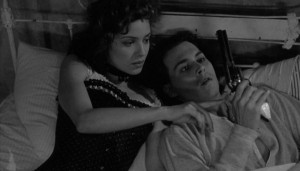 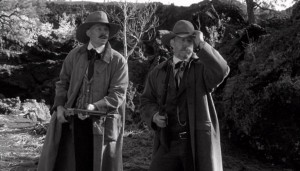 |
|
|
3. Dead Man (Jim Jarmusch, 1995). Having written a short book (BFI Publishing, 2000) about this black and white post-western, Jarmusch’s best movie to date, I couldn’t dream of omitting it from my list. It’s the only western I know that assumes Native Americans are part of the audience (and even addresses them with a few unsubtitled jokes). It’s the Johnny Depp film in which the actor’s resemblance to Buster Keaton seems most suitable. (He plays an accountant from Cleveland called William Blake). His costar, Gary Farmer, creates the richest and warmest character in any Jarmusch movie (as Nobody, a Native American outcast who’s half Blood and half Blackfoot). Dead Man has the last film performance of Robert Mitchum and a sublime improvised score by Neil Young, as well as wonderful bits by Billy Bob Thornton, Lance Henrikson, Mili Avital, and Iggy Pop. It’s a meditation about death that’s poetic and scary, and an unvarnished view of frontier capitalist America that’s both contemporary and devastating. I suspect it’s the latter characteristic that has freaked out some (American) viewers the most.
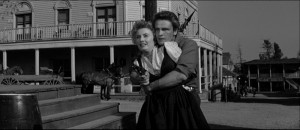
|
| 4. Forty Guns (Samuel Fuller, 1957). Fuller’s first two films, I Shot Jesse James (1949) and The Baron of Arizona (1950), are westerns, but it’s his next two westerns, both made in 1957, that are the most interesting, Run of the Arrow and Forty Guns. Only the latter is available, but it’s probably the best and craziest anyway. Shot in black and white CinemaScope in less than ten days (according to Jean-Luc Godard, who wrote the first French review), it stars Barbara Stanwyck as the boss lady with forty guns (or is it studs?) on her ranch. Fuller’s preferred title was The Woman with a Whip. This contains one of the lengthiest takes and tracking shots in the history of Hollywood, but it’s the violence and the hysteria that one mainly remembers. (Recalling the way a sexy gunsmith playfully points a shotgun at her boyfriend, Godard included an homage with Jean-Paul Belmondo and Jean Seberg in his Breathless.) With Barry Sullivan and Dean Jagger. |
|
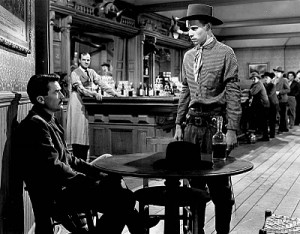
|
5. The Gunfighter (Henry King, 1950). King — who lived to the ripe age of 96, and was almost 30 when he directed his first film in 1915 — had a distinguished career in the silent period with a special feeling for Americana. This reputation eventually became tarnished when he wound up with too many mediocre assignments as a journeyman director at Fox. But the probable peak of his late period is this sensitive and deeply felt demystification of the classic western, starring Gregory Peck as an aging gunman with a period moustache who finds himself menaced and beleaguered by his own notoriety, including young toughs who want to make their mark by outdrawing him. A moody character study in black and white with more feeling than action, this predictably lost money at the boxoffice, which is probably why it hasn’t yet surfaced on DVD except for in the U.K., but along with Track of the Cat (see below), it’s one the greatest art westerns, miles ahead of the pompous and campy Shane. Karl Malden runs the saloon and Millard Mitchell is the sheriff.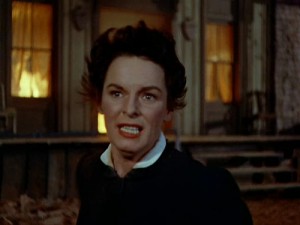 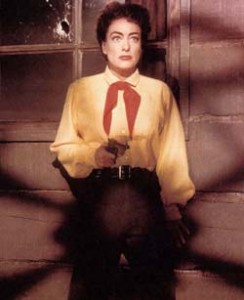 |
| 6. Johnny Guitar (Nicholas Ray, 1954). “The Beauty and the Beast of Westerns,” François Truffaut once called it —- perhaps thinking of the fairy-tale waterfall leading to Scott Brady’s hideout. (For the extra-observant, the word “God” is scrawled on a nearby tree, for no better reason than to express Ray’s swagger — or maybe the same feeling for the cosmic that informed the planetarium in his Rebel without a Cause the following year.) This is the first truly hip western, the 50s movie that was most explicit about attacking the McCarthyite witch-hunts, and a baroque stylistic exercise in terms of mise en scène and cadenced dialogue. It sometimes seems to be on the verge of breaking into a musical, with the title hero (Sterling Hayden) pitted against The Dancing Kid (Brady), and Vienna (Joan Crawford) constituting what they’re fighting about. It’s also the first color film on which Ray had artistic control —- consider how flamboyantly he can brandish a teenage boy’s yellow shirt, or what he does with the blazing fire that sexually excites the perverse villainess (Mercedes McCambridge) when she’s burning down Vienna’s saloon. She’s a figure out of Greek tragedy rather than a musical, so maybe this is the movie that taught the French New Wave how to mix genres. |
|
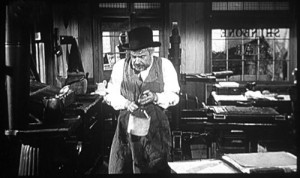
|
7. The Man Who Shot Liberty Valance (John Ford, 1962). John Ford uses John Wayne, James Stewart, Vera Miles, Lee Marvin (the title villain), Edmond O’Brien, John Carradine, John Qualen, Andy Devine, Woody Strode, and Strother Martin, among others, to recollect and rethink his own career as a maker of westerns and what all those legends he was helping to perpetuate meant. What he comes up with is ambivalent, complex, and so clouded with ambiguity about the misperceptions of history and heroism that Andrew Sarris called his essay about this black and white film “Cactus Rosebud”. It’s also a kind of melancholy ghost sonata. If you’re getting a little tired of black and white westerns on this list, be assured that this is the fifth and next to last.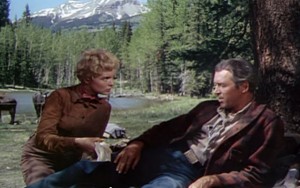 |
8. The Naked Spur (Anthony Mann, 1953). And for natural splendors in color, you couldn’t do better than this gorgeous piece of landscape art, shot almost entirely in exterior locations in the Colorado Rockies. James Stewart plays a rather nasty and troubled bounty hunter—-a character diametrically opposed to his civilized lawyer from the east in The Man Who Shot Liberty Valance —- and it’s characteristic of Mann’s best and most elemental western that, along with the four other characters, he never changes his clothes even once. (The other four are Janet Leigh, Robert Ryan, Ralph Meeker, and Millard Mitchell, and the shifting dramatic geometry in terms of alliances and conflicts is part of what makes this film so brilliant.) Perversely, it’s both Mann’s greatest western and the last major one to come out on DVD, finally appearing in a James Stewart box set this August.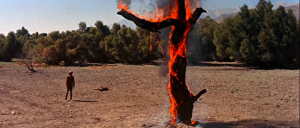 |
|
|
9. Ride Lonesome (Budd Boetticher, 1959). If you start toting up the spectacular lacunae so far in westerns commercially available on DVD, the five Ranown westerns made by Boetticher with Randolph Scott have to be somewhere near the top of the list. “Ranown” was a production company named after the first three letters of Randolph Scott’s first name and the last three letters of the last name of Harry Joe Brown, Scott’s coproducer. The only “Ranown” western on DVD — Seven Men from Now (1956), recently restored — isn’t bad, and it comes with a documentary about Boetticher. But technically it isn’t a Ranown western, though it’s often called one, because the production company was John Wayne’s, and Brown wasn’t connected to it. (Another ersatz Ranown western is Sam Peckinpah’s 1962 Ride the High Country, which is said to “sum up” the cycle, and is also available.) And I wouldn’t call Seven Men from Now the best of the Boetticher-Scott collaborations either. |
I’ve selected Ride Lonesome because it’s in ‘Scope and, if memory serves, is more cheerful (despite its title) than Comanche Station (1960), another ‘Scope film that ended the series. Buchanan Rides Alone (1958), a western about greed which preceded both, is my other favorite (although I still have an abiding affection for the 1969 A Time for Dying, one of Boetticher’s most unsung oddities, with Audie Murphy). The other two Ranown westerns are The Tall T and Decision at Sundown, both 1957. It’s so hard nowadays to see any of them that I might shift my allegiances if I saw them all again, but Ride Lonesome has two other pluses: an intricate Burt Kennedy script and the first film role of James Coburn.
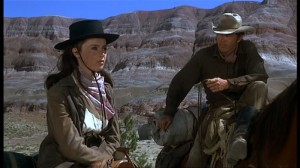
10. The Shooting (Monte Hellman, 1966). The only truly avant-garde western on my list (although Johnny Guitar arguably comes close), scripted by Carole Eastman under the pseudonym Adrian Joyce. Hellman shot it over about 18 days, back to back with the somewhat more conventional western Ride in the Whirlwind, and then spent about half a year editing both. Brad Stevens’ excellent Monte Hellman: His Life and Films (Jefferson, NC/London: McFarland & Company, 2003) links this odd movie, which he calls Hellman’s first masterpiece, to Samuel Beckett’s Waiting for Godot, but I’m more prone to view it as the best western Alain Resnais never made. It’s also the first movie Hellman made with his most quintessential actor, Warren Oates — who went on to play other indelible parts in Hellman’s Two Lane Blacktop (1971), Cockfighter (1974), and his last western to date, China 9, Liberty 37 (1978) —- and Oates’ memorable costars are Jack Nicholson (who coproduced the film with Hellman), Millie Perkins, and Will Hutchins. If it weren’t so funny in its inimitable absurdist way, I suppose one could call it pretentious, but only at the risk of missing all the scary fun.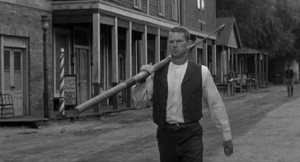 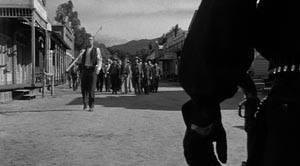 |
|
|
11. Terror in a Texas Town (Joseph H. Lewis, 1958). The underrated Lewis, best known for his wonderful 1949 nonwestern Gun Crazy, directed other singular westerns apart from this exceptionally weird one in black and white ‘Scope — including a couple with Randolph Scott, A Lawless Street(1955) and 7th Cavalry (1956), and The Halliday Brand (1957). Terror in a Texas Town is singular both for its unabashed anticapitalist theme —- it was written pseudonymously by the blacklisted Dalton Trumbo, who used Ben Perry as a front — and for some of the worst acting ever to be found in a good movie (check out especially Nedrick Young as the gunslinger heavy). But I hasten to add that Sterling Hayden, the star, is exceptionally fine. He plays a peaceable Swedish seaman from the east who turns up in the very corrupt title town to visit his father, a farmer, only to find that he’s just been coldbloodedly gunned down. Stalking the killer with a harpoon instead of a rifle, he cuts a formidable figure. 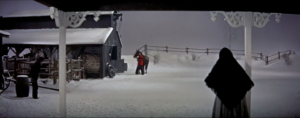
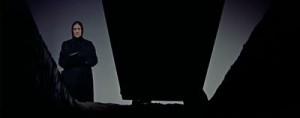
|
| 12. Track of the Cat (William Wellman, 1954).The strangest thing of all about this singular art western by a hard-nosed veteran (whose other westerns include The Ox-Bow Incident, Yellow Sky, Westward the Women, and Across the Wide Missouri) is that John Wayne produced it. Reportedly, after Wellman made Wayne a fortune by directing him in The High and the Mighty, Wayne said, in effect, “Anything you want, Bill,” and Wellman chose to film a first-draft adaptation by A.I. Bezzerides (Kiss Me Deadly) of a symbolic William van Tilburg Clark novel set in Nevada, filmed in color and ‘Scope but designed mainly in black and white. A claustrophobic tale of a snowbound, neurotically dysfunctional family whose bickering siblings include Robert Mitchum, Teresa Wright, and Tab Hunter, and whose parents are an alcoholic and a prude, it could be described as the American Ordet — and it includes a Dreyerlike funeral partially shot from the viewpoint of the corpse in the ground. One wonders what Wayne might have thought when he saw this wonderful picture. But the bottom line in this case is that it’s great not because it’s eccentric but in spite of the fact that it is. |




















